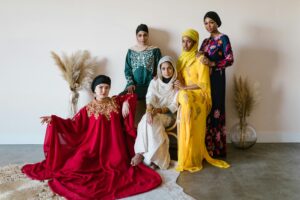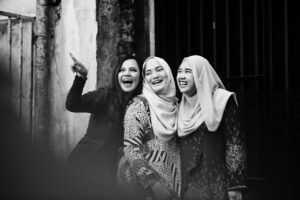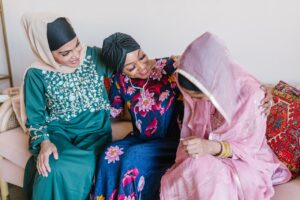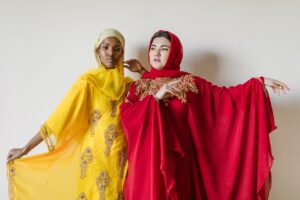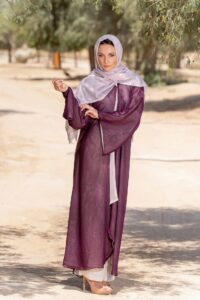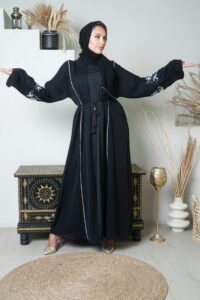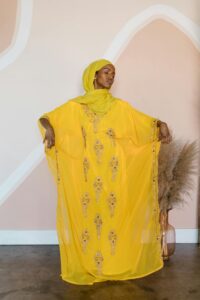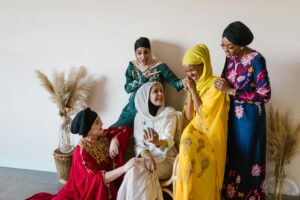The Ladies Abaya Fashion: A Symbol of Modesty, Culture, and Empowerment
Introduction
The abaya, a long, flowing garment worn by women in many Muslim-majority countries, holds a significant place in both traditional and contemporary fashion. The garment, traditionally black, serves as an outer layer that covers a woman’s clothing, reflecting modesty in alignment with Islamic values. However, its cultural, social, and even political implications stretch far beyond its fabric and design. Today, the abaya has evolved to be a symbol of modesty, empowerment, and cultural identity, all while keeping pace with the global fashion industry.
The journey of the abaya through history, its influence on modern fashion, and its varied meanings in different cultural contexts are worth exploring to fully understand this iconic piece of clothing. This article delves into the origins, evolution, significance, and modern iterations of the abaya, highlighting its role in both preserving tradition and fostering contemporary expressions of femininity and faith.
1. Historical Origins of the Abaya
The abaya’s origins are deeply rooted in ancient history, with influences from the Arabian Peninsula and other regions of the Middle East. While the exact date of its inception is hard to pinpoint, historical records suggest that women in Mesopotamia, one of the earliest known civilizations, wore long, flowing garments that resembled the modern abaya. These garments were often loose-fitting and draped. over the body, primarily serving to provide protection from the harsh desert environment, as well as symbolizing status.
By the advent of Islam in the 7th century, the abaya and similar coverings became more widespread as expressions of modesty. The Islamic principles of hijab, which refer to both the concept of modest dress and behaviour, reinforced the use of clothing that concealed a woman’s body. Early Islamic society adopted these modest forms of dress, blending pre-existing cultural practices with religious teachings. Thus, the abaya became more than just a protective garment; it became an embodiment of modesty and piety, as prescribed in Islamic teachings.
Influence of Islamic Jurisprudence
In Islamic jurisprudence, there is no specific mention of the abaya by name, but the Quran encourages women to dress modestly. In Surah Al-Ahzab (33:59), it is stated:
“O Prophet, tell your wives and your daughters and the women of the believers to bring down over themselves their outer garments. That is more suitable that they will be known and not be abused.”
This verse highlights the idea of wearing an “outer garment” for modesty, which over centuries has been interpreted in different ways. For many women in the Arabian Peninsula, this translated into the wearing of the abaya.
However, regional differences in interpreting and implementing modest dress codes meant that while the abaya became synonymous with women’s clothing in the Gulf countries, other forms of modest dress appeared in different parts of the Muslim world, such as the chador in Iran or the jilbab in other regions.
2. Cultural Significance of the Abaya
A Symbol of Identity and Tradition
In many cultures, the abaya is more than just a garment; it is a powerful symbol of cultural identity. In countries like Saudi Arabia, the United Arab Emirates, and Qatar, the abaya serves as a marker of traditional values. Women often wear the abaya as a way to express their pride in their cultural heritage, and it is deeply associated with the social and religious fabric of these nations.
Despite its historical and religious connotations, the abaya also represents the continuity of cultural identity through generations. Mothers often pass on the tradition of wearing the abaya to their daughters, making it an integral part of family customs and values. The abaya is donned at important social events such as weddings, religious holidays, and family gatherings, further solidifying its importance as a cultural staple.
Religious Significance
In Islam, modesty is an essential tenet, both in conduct and in dress. For many women, wearing the abaya is a way to adhere to the principles of hijab, which not only emphasize modest dress but also modest behaviour. The abaya provides a layer of modesty by concealing the shape of the body, aligning with the Islamic ideal of protecting a woman’s beauty and keeping it private, rather than public.
However, it’s important to note that while many women wear the abaya as an expression of their faith, the garment is not mandatory in all Muslim cultures. The decision to wear it often stems from personal beliefs and cultural norms, and the exact nature of modest dress varies across different Muslim communities around the world. For example, while the abaya is widely worn in Gulf countries, women in Southeast Asia or North Africa may opt for different forms of modest attire, such as the kebaya in Indonesia or the djellaba in Morocco.
3. The Evolution of the Abaya in Modern Times
A Fashionable Transformation
Traditionally, the abaya was a simple, black cloak made of modest fabric like cotton or wool, designed primarily for function rather than fashion. However, as global fashion trends began influencing local styles, the abaya underwent a significant transformation, evolving into a fashion statement while maintaining its modest character. The modern abaya now comes in a variety of designs, fabrics, and colours, incorporating embroidery, lace, crystals, and even bold prints.
High-end designers from the Middle East and beyond have embraced the abaya as a canvas for artistic expression. Designers like Hatem Alakeel and brands such as Mauzan have modernized the abaya, giving it contemporary cuts, asymmetrical shapes, and embellishments that allow women to make individual fashion statements while adhering to cultural norms of modesty.
Fashion-forward abayas are now sold in luxury boutiques alongside international fashion labels, symbolizing the growing influence of Middle Eastern fashion on the global stage. The introduction of the abaya to international fashion weeks in cities like Paris and London underscores its increasing global appeal.
The Abaya and Social Change
The evolution of the abaya into a fashion item mirrors larger societal changes, especially in the Gulf region. Women today are more visible in the public sphere, pursuing careers, higher education, and leadership roles in unprecedented numbers. The modern abaya reflects this shift, with styles that cater to professional women, athletes, and public figures, who desire garments that allow them to express their identities while fitting into contemporary lifestyles.
In many ways, the evolution of the abaya is symbolic of the broader changes occurring in the role of women within these societies. It represents a blending of tradition with modernity, a sign that women can maintain cultural practices while asserting their presence in new and dynamic ways.
4. Regional Variations and Interpretations
Though the abaya is most closely associated with the Gulf countries, it is not the only form of modest dress worn by Muslim women around the world. There are numerous variations and interpretations of modest clothing that reflect regional customs, climates, and styles.
Saudi Arabia
In Saudi Arabia, the abaya is perhaps the most iconic, historically worn in its simplest, all-black form. However, even within Saudi culture, regional differences exist. In cities like Riyadh and Jeddah, where cosmopolitan influences are stronger, modern, designer abayas are quite popular. Women in these areas are more likely to experiment with colours, fabrics, and embellishments, whereas in more conservative regions, the traditional, unadorned black abaya remains the standard.
United Arab Emirates (UAE)
In the UAE, the abaya is often seen as a form of high fashion. Emirati women frequently wear abayas made of luxurious materials, such as silk and chiffon, adorned with intricate embroidery, Swarovski crystals, and other embellishments. The abaya is not just a garment for everyday wear, but also a fashion statement at weddings, family celebrations, and official events.
Oman and Yemen
In Oman and Yemen, the abaya is typically worn with a headscarf (hijab) and often features unique regional details, such as intricate, brightly colored embroidery along the sleeves and hemline. Yemeni abayas may also include more conservative features, such as gloves or face veils (niqabs), reflecting local customs around modesty.
Morocco and North Africa
While the abaya itself is not as commonly worn in North Africa as it is in the Gulf, women in countries like Morocco wear the djellaba, a similar long, flowing robe with a hood. The djellaba serves much of the same purpose as the abaya, providing coverage and modesty, but it is often worn in more colorful fabrics and patterns, reflecting the rich cultural tapestry of the region.
Southeast Asia
In countries like Indonesia and Malaysia, where the majority of Muslims are found in Southeast Asia, women often wear the kebaya, a long-sleeved blouse paired with a long skirt, or the baju kurung, a loose-fitting dress. While these garments serve similar purposes to the abaya in terms of modesty, their designs are much more colorful and reflect the vibrant cultural influences of the region. The abaya, in its Gulf form, is less common but still worn, especially in urban areas with larger Arab expatriate populations.
5. The Abaya as a Political and Social Symbol
Gender and Politics
The abaya has often found itself at the intersection of political, social, and gender debates. In some countries, the abaya and similar forms of modest dress are seen as symbols of women’s oppression, with critics arguing that such garments limit a woman’s freedom of expression and reinforce patriarchal control over women’s bodies.
In contrast, many women who wear the abaya view it as a liberating choice, emphasizing that modest dress allows them to be judged based on their intellect, character, and accomplishments rather than their physical appearance. For these women, the abaya represents autonomy, self-respect, and an adherence to deeply held religious and cultural values.
In Saudi Arabia, where wearing the abaya was once legally required, changes in the country’s laws have sparked discussions about the garment’s place in society. Crown Prince Mohammed bin Salman’s reforms, which include lifting the mandatory abaya-wearing rule, have been met with both support and opposition. While some women have embraced the freedom to wear alternative forms of modest dress, others continue to wear the abaya as a statement of cultural and religious identity.
Empowerment through Choice
The abaya, for many women, is ultimately about choice. Whether they choose to wear it for religious reasons, cultural pride, or personal style, the abaya allows women to express their identities in ways that align with their values. In recent years, movements promoting modest fashion, both in Muslim-majority countries and in the West, have highlighted the importance of women being able to choose how they dress without facing judgment or stereotypes.
Social media platforms have played a significant role in this shift, with influencers from the Middle East, Asia, and beyond showcasing their unique takes on modest fashion. Through platforms like Instagram and YouTube, women are redefining what it means to wear the abaya, blending traditional modesty with contemporary style in ways that resonate with a global audience.
Conclusion
The abaya, a garment steeped in tradition and religious significance, has come a long way from its humble origins. It continues to serve as a powerful symbol of modesty, identity, and empowerment for millions of women worldwide. As the abaya evolves alongside the women who wear it, it remains a reflection of the ongoing dialogue between tradition and modernity, faith and fashion, and personal choice and cultural expression.
In an increasingly globalized world, where fashion often reflects deeper social and political currents, the abaya stands as a testament to the complexity and richness of Muslim women’s identities. Whether worn for religious devotion, cultural pride, or as a personal fashion statement, the abaya represents a unique intersection of tradition, modernity, and empowerment. As both a cultural symbol and a fashion-forward garment, the abaya continues to be a versatile and evolving expression of women’s roles in a changing world.



